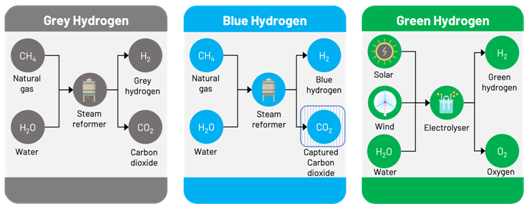How Emerging Technologies Can Accelerate the Uptake of Green Hydrogen
Written by Moshen Khorasany
Stimulated by recent concerns about climate change, countries are establishing ambitious goals for reducing greenhouse gas (GHG) emissions. The billion-dollar question is, “how can GHG emissions be reduced to net zero by 2050 to limit the long-term increase in average global temperature to 1.5 °C?” Everyone agrees that shifting from fossil fuels to renewable resources has a central role in helping the world reach net-zero emissions by 2050. This transition, however, should be done for different sectors. Renewables play an essential role in reducing emissions in buildings, industry, and transport. However, the challenge is that not all sectors can be easily electrified using renewable resources. That’s why hydrogen is back in business. Hydrogen, which was initially used as a fuel in the early 19th century, is back and will be a key player in the decarbonization journey.
Hydrogen is a versatile energy carrier suitable for decarbonizing sectors without electricity grid access or as a carbon-neutral feedstock for chemical processes. Its potential for many different uses makes it an up-and-coming alternative for those sectors where decarbonization and electricity use are more complex1, for example, in the steelmaking, chemical, and refinery industries, and heavy transportation by land, air, and sea. Using hydrogen in different sectors and adoption of cleaner technologies for its production enable hydrogen to avoid up to 60 Gt of emissions until 2050, representing 6% of total cumulative emissions reductions2.
The fact is that not any type of hydrogen is a solution for decarbonization. Hydrogen production must also become much cleaner than it is today. Hydrogen can be produced from various energy sources, such as reforming natural gas, oil, or coal, a by-product of chemical processes, and by electrolysis powered by renewables and nuclear energy. The hydrogen produced via reforming of fossil sources is designated as grey, whereas if carbon emissions are captured, stored, or used, it is considered blue hydrogen. Hydrogen produced using renewable feedstock and renewable energy resources is classified as green hydrogen. Compared to blue and grey hydrogen, which have a considerable carbon footprint, green hydrogen has no emission when it burns as a fuel.
Figure 1: Different pathways for hydrogen production.
Indeed, more green hydrogen is needed, but the current production of green hydrogen is limited. In 2021, total global hydrogen production was 94 million tonnes, with associated emissions of more than 900 million tonnes3. Natural gas without carbon capture is the main route and accounted for 62% of hydrogen production in 2021, and coal-based hydrogen forms 19% of global production. Low-emission hydrogen production was less than one million tonnes in 2021, almost all from fossil fuels with carbon capture. The importance of green hydrogen and the fact that its production is limited are indisputable. Besides, it is known that regardless of the production pathway, the final product is the same, hydrogen. So, the question is, how can we guarantee the origin of hydrogen to ensure it is green or low carbon?
The uptake of green hydrogen will rely on the widespread acceptance of tracking instruments to certify its origin, ensuring that its production depends on renewable energy resources. Therefore, an assurance mechanism is needed to provide hydrogen consumers with transparent, traceable, and complete information about the origin and carbon footprint of the hydrogen they use. This assurance mechanism can be implemented through a guarantee of origin scheme. A guarantee of origin certificate is an electronic document that provides proof that a given quantity of hydrogen is produced by a registered production device, meeting specific quality criteria and production methods. It provides a consistent and accurate approach to tracking the key attributes associated with hydrogen production, particularly its carbon footprint. The guarantee of origin certificate also helps avoid double counting by enabling consumers to claim a certain volume of energy generated. The certification provides more transparency to stakeholders leading to more open market trading. It also encourages new investments in green energy resources.
Any certification scheme requires sensitive data to be controlled between different parties with privacy, transparency, and security. This is where blockchain as an information layer comes into the scene. Blockchain provides a digital record-keeping system that supports highly sensitive data sharing with the improvement of security and privacy using cryptography. It creates a complete and transparent history of information and financial flows in transactions, which provides end-to-end visibility over the supply chain4. All of these properties make blockchain a perfect tool for the guarantee of origin certification.
Blockchain can act as a digital notary to track the origin of hydrogen to ensure its production meets a set of quality criteria. Any certificate issued includes information about the emission intensity of the product, the production facility and its location, the production technology, as well as the primary fuel source of the produced hydrogen. When a certificate is issued, the data is digitized, and a digital identity is assigned to each certificate. This way, blockchain technology can accelerate the adoption of green hydrogen by adding trust to each step of its production.
References
- Gearhart, Chris. "Hydrogen: What's Different Now [Technology Leaders]." IEEE Electrification Magazine 6.1 (2018): 4-7.
- IEA (2021), Net Zero by 2050, IEA, Paris https://www.iea.org/reports/net-zero-by-2050.
- IEA (2021), Global Hydrogen Review 2021, IEA, Paris https://www.iea.org/reports/global-hydrogen-review-2021.
- Bodkhe, Umesh, et al. "Blockchain for industry 4.0: A comprehensive review." IEEE Access 8 (2020): 79764-79800.
This article was edited by Binesh Kumar.
To view all articles in this issue, please go to February 2023 eBulletin. For a downloadable copy, please visit the IEEE Smart Grid Resource Center.

Mohsen Khorasany (SMIEEE) is an energy specialist with a focus on climate and sustainability, energy transition, and empowering organizations and individuals to act. He received the B.Sc. degree and M.Sc. degrees, both in Electrical Engineering, in 2010 and 2012, respectively. He completed his Ph.D. studies in the same field at the Queensland University of Technology in 2020. He has extensive experience as an engineer and a researcher in supporting the integration of clean energy technologies in energy systems. He has written numerous research articles and whitepapers that provide cutting-edge knowledge and innovative solutions to facilitate decarbonization and decentralization of the energy sector. Currently, he works with TYMLEZ as the head of research and innovation, leading the research behind the TYMLEZ innovative solutions.
To have the Bulletin delivered monthly to your inbox, join the IEEE Smart Grid Community.
Past Issues
To view archived articles, and issues, which deliver rich insight into the forces shaping the future of the smart grid. Older Bulletins (formerly eNewsletter) can be found here. To download full issues, visit the publications section of the IEEE Smart Grid Resource Center.





